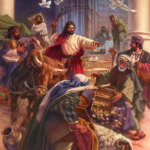The text for this lesson is John 2:1–11
Key Point
- In His first miracle at Cana in Galilee, Jesus showed that He is God. Through God’s Word and physical means—water, bread, and wine—God shows us that Jesus is our Savior.
- Law: Like the disciples, I am unsure of who Jesus is.
- Gospel: Through His Word and Sacraments, Jesus shows He is my Savior and God.
Discussion Points
- We see the true humanity of Jesus in His attendance at the wedding at Cana, where He no doubt enjoyed the delicious food and wine and had a wonderful time with His friends. At another time, we see Jesus go off into the wilderness to fast for forty days. And later, we see His great agony in the Garden of Gethsemane and in His Passion. How are these different parts of Jesus’ life typical of our own lives?
- Jesus performed an amazing miracle at the wedding at Cana by changing water into wine. This demonstrated His divine attribute of omnipotence, that is, being all-powerful. How does Jesus use His omnipotence today for our benefit?
- In order to interpret John’s Gospel, it is important to understand how he arranges his material. As we see in the outline (on the next page), the Book of Signs is made up of seven signs, the number 7 often indicating completeness in the Bible. John 2:11 tells us that the miracle at Cana is the “first of His signs.” What is the significance of the sign He performed at Cana? How did this sign function for His disciples? See John 1:50 and 2:11. How does it function for us? See John 20:30–31.
- We have seen that the purpose of the miracle at Cana—and all the other signs—is to reveal Jesus’ glory and strengthen the faith of His followers. Read Isaiah 25:6 and Amos 9:13, two prophecies related to the expected age of the Messiah. What about Jesus’ miracle at Cana, in particular, revealed His glory and showed that the Messiah had come?
- The first part of John’s Gospel is called the Book of Signs and the second is the Book of Glory. Read John 1:14; 2:11; and 8:54 for references to Jesus’ glory in the first part of John. Then reread John 12:23–24 and 17:1. Why is it significant that the words glory and hour appear together in these verses? Read John 19:2–3, 19. In what way is Jesus portrayed as a king? Why is it so shocking that Jesus’ glory is to be found at the hour of His crucifixion?
- Jesus’ signs reveal who He is for the disciples and for us. Yet not everyone got His signs. Often, people missed the underlying meaning. Read John 6:26, 34–35. Why were the people seeking Jesus? What was the true meaning of the sign that He had performed (the feeding of the five thousand)? How does focusing solely on the miraculous nature of Jesus’ signs continue to lead people astray today?
6066T2







